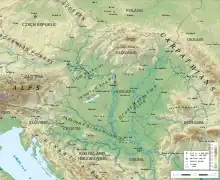| Battle of Nedao | |||||||
|---|---|---|---|---|---|---|---|
| Part of Germanic-Hunnic Wars | |||||||
 Topographic map of Carpathian Basin | |||||||
| |||||||
| Belligerents | |||||||
|
Gepids Heruli Rugii Sciri Suebi |
Huns Alani | ||||||
| Commanders and leaders | |||||||
| Ardaric | Ellac †[2] | ||||||
The Battle of Nedao was a battle fought in Pannonia in 454 CE between the Huns and their former Germanic vassals. Nedao is believed to be a tributary of the Sava River.[3]
Battle
After the death of Attila the Hun, allied forces of the subject peoples under the leadership of Ardaric, king of the Gepids, defeated the Hunnic forces of Ellac, the son of Attila, who had struggled with his brothers Ernak and Dengizich for supremacy after Attila's death. Ellac himself was killed in the battle.[4]
According to the 6th-century historian Jordanes:
And so the bravest nations tore themselves to pieces. For then, I think, must have occurred a most remarkable spectacle, where one might see the Goths fighting with pikes, the Gepidae raging with the sword, the Rugii breaking off the spears in their own wounds, the Suavi fighting on foot, the Huns with bows, the Alani drawing up a battle-line of heavy-armed and the Heruli of light-armed warriors... ...after many grave clashes, victory surprisingly favours the Gepids for the sword and plotting of Ardaric killed nearly thirty thousand men, Huns as well as other tribes who brought them aid. In this battle, the eldest son of Attila, named Ellac, whom his father was said to have loved so much more than the rest that he favoured him above all his various sons in his empire, was killed.[5]
According to the medieval Hungarian chronicles:
But Detre of Verona and the German princes plotted, as during his rule, King Attila sat on their necks, they divided the unified Hun community into factions; some wanted to make Csaba king after Attila, the son of Emperor Honorius of Greece, who was the daughter of King Attila, while others wanted Aladar, who was born to Princess Krimhild of Germany. The smarter part of the Huns were drawn to Csaba, the foreign lineage, with few Huns, to Aladar: both began to rule; when each wanted to surpass the other, the cunning Detre, who was with Aladar in Sicambria at that time, created such a fierce and strong battle between the two kings that the Danube flowed continuously with German blood for fifteen days; in those days, the Huns carried out such a massacre that if the Germans did not conceal it out of hatred, they would indeed have to admit that from Sicambria to Potentiana, neither humans nor dumb animals could drink clean water from the Danube. This is the battle that the Huns still call the Battle of Krimhild to this day. In these battles, Csaba and the Huns always emerged victorious; later, however, Detre of Verona defeated Csaba through treachery. At first, Csaba defeated his brother, but later he was the one who was defeated, to the extent that barely fifteen thousand remained on Csaba's side; the Huns and Attila's sons were completely wiped out, killed. After Attila's death, his sons and the Huns killed each other. Therefore, the defeated Csaba and his brothers, the sons of Attila who were opposed to him, sixty in number according to tradition, fled to their great-grandfather, Honorius, with fifteen thousand Huns. However, although Emperor Honorius wanted to settle them in Greece, they did not stay but returned to Scythia, to their ancestral seat, to remain there.
Modern views
Jordanes claimed that at the Battle of Nedao the Ostrogoths fought against the Huns, but this is rejected by modern historians such as Herwig Wolfram[7] and Hyun Jin Kim. The latter believes that this is a forged story and that the Ostrogoth king Valamir himself fought alongside the Huns.[8] Alternatively, J.R. Martindale and Franz Altheim accept that the Ostrogoths were among the victors of Nedao, while many others, including Otto J. Maenchen-Helfen, believe that none of this existed at all.[9]
Aftermath
Hunnic dominance in Central and Eastern Europe was broken as a result of the battle. It is hard to reconstruct the exact course of events, but by the early 460s the Hunnic Empire was dissolved with the Gepids, Rugii, Heruli, Suebi, and Ostrogoths achieving independence[10] and eventually becoming federates of the Eastern Roman Empire.[11] The Huns, reorganized under Dengizich, moved to the east, where they attacked the Eastern Roman Empire and were decisively defeated in 469. After that point, the Huns cease to exist in European history.[4]
See also
References
- ↑ Nic Fields, The Hun: Scourge of God AD 375–565, (Osprey Publishing, 2006), 16.
- ↑ Attila, N.Th.J. Voorwinden, A Dictionary of Medieval Heroes, transl. Tanis Guest, ed. Willem Pieter Gerritsen, Anthony G. Van Melle, (Boydell & Brewer, 2000), 46.
- ↑ Wolfram 1990, p.258.
- 1 2 History of Humanity: From the seventh century B.C. to the seventh century A.D., UNESCO, 1996, ISBN 92-3-102812-X, p.243.
- ↑ Jordanes, Origins and History of the Goths, l.261.
- ↑ Mark of Kalt: Chronicon Pictum
- ↑ Wolfram 1990, p.259.
- ↑ Kim, Hyun Jin (2013). The Huns, Rome and the Birth of Europe. Cambridge University Press. p. 113. ISBN 978-1-107-00906-6.
- ↑ Wolfram 1990, p.448, note 87 reflects the scholarly debate on the matter.
- ↑ The Cambridge Ancient History, vol 14, p. 18. ISBN 0-521-32591-9.
- ↑ Wolfram 1990, p.260.
Sources
- Dıngıl Ilgın, Fatma Aysel. "The Battle of Nedao and its Importance in Eastern European Turkish History". Journal of Old Turkic Studies. 3 (2): 310–320.
- Mingarelli, Bernardo (2018). Collapse of the Hunnic Empire: Jordanes, Ardaric and the Battle of Nedao (PDF) (MA thesis). University of Ottawa.
- Herwig Wolfram. History of the Goths, transl. Thomas J. Dunlap., University of California Press, 1990, ISBN 0-520-06983-8.